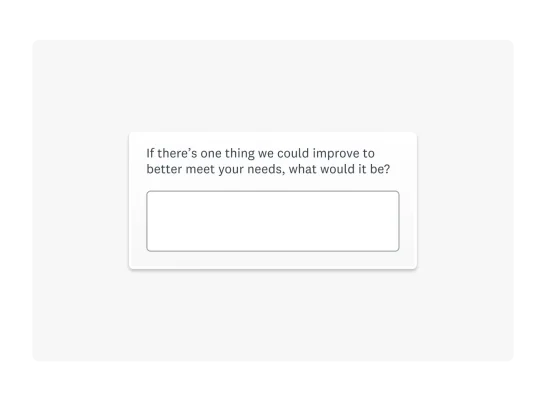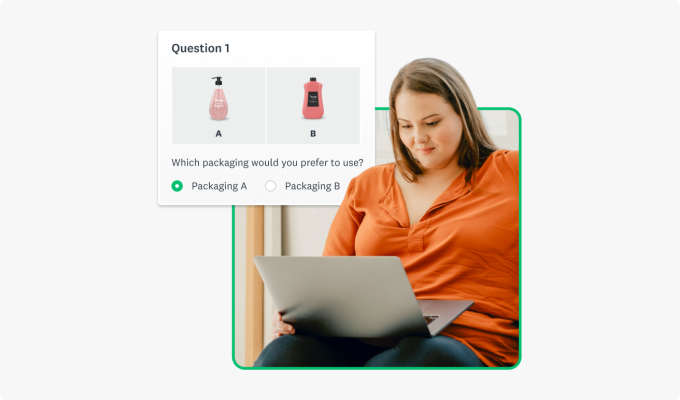How to conduct qualitative research in 5 easy steps
From data collection to analysis, learn the most effective approach to the qualitative research process.

Think about your last conversation with someone. You probably asked questions, solved a problem, or learned more about conversation partners.
Qualitative research–used to learn about human behavior and motivations–is a lot like a good conversation. With some structure and best practices, you’ll be ready to gain valuable insights about the people who matter to your business or organization.
Keep reading for a step-by-step explanation of how to conduct qualitative research, along with examples and tips from our experts.
How to conduct qualitative research
Before we outline five steps you can follow in your qualitative research, you first need to know what qualitative research methodology means. We’ll start with a definition and examples before showing you how to run your own research.
What is qualitative research?
Qualitative research focuses on gathering descriptive data to investigate impressions and opinions. It’s focused on understanding the why of human behavior, motivations, and experiences.

When planning your methodology, you typically choose between qualitative and quantitative research. The main distinction is that quantitative research focuses on numerical data and hard facts.
With quantitative research questions, you’re generally collecting data to measure, predict, or validate. In contrast, qualitative research focuses on understanding your research subjects’ opinions, emotions, or actions.
Typically, qualitative research relies on interviews, focus groups, observation, and surveys with open-ended questions inviting written responses. Quantitative research might use experiments, studies, or surveys (with questions designed for data analysis, like the agree/disagree scale).
Pros and cons of qualitative research
As with any research methodology, the qualitative approach has advantages and pitfalls.
Qualitative research methodology pros
The strengths of qualitative research include:
- Open-ended questions can help you better understand more intangible concepts that are difficult to quantify (e.g., why does this neighborhood appeal to you compared to that one?)
- Researchers gain the ability to ask follow-up questions and clarify answers
- Focus groups and interviews can provide context for performance metrics (e.g., cart abandonment or product returns)
- Capturing subjective insights can help you humanize data in a unique way
Cons of the qualitative research process
Potential weaknesses of qualitative research methods include:
- Descriptive data can be challenging to analyze objectively
- This approach can be more costly and time-consuming
- It can be more difficult to generalize the feedback to your target population as sample sizes are typically smaller
Qualitative research methodology examples
Qualitative research can prove valuable in many industries. Consider these examples:
- A company looking to perform market research might conduct focus groups or interviews to learn how potential customers perceive their new product.
- Marketers trying to understand the buyer’s journey might use qualitative surveys or interviews to uncover the steps someone takes before purchasing. They also might want to understand their pain points.
- A tech product development team trying to innovate might do observational research to see how people interact with their existing devices.
Now, let’s focus on how to do your own qualitative research in five straightforward steps.

How to conduct qualitative research in 5 easy steps
You’ll want to shape your qualitative research methodology to suit your goals. That said, as is true with the many types of survey research, you can still follow a standard path to develop your unique approach:
1. Identify your question, problem, or goal
What is the first step of the qualitative research process? You need to determine what you want to accomplish.
Perhaps you want to do primary research to answer specific business questions. Or you’re doing exploratory research to better understand an issue. The clearer you are about what you want to accomplish, the better able you’ll be to follow the rest of the steps outlined here.
Imagine a market researcher identifying a niche target audience for a new craft beer in a crowded market. Their goal might be to understand this audience and effectively stand out during the product launch.
2. Make your hypothesis
A hypothesis helps focus your qualitative research. When you have a hypothesis as your starting point, you can ensure your methods align with your specific goal, problem, and questions.
For our craft beer market researchers, a hypothesis might be: "Millennial craft beer consumers prefer beer with unique flavor profiles, such as fruit-infused or sour varieties, due to their desire for novelty and differentiation.”
This hypothesis could guide exploration, like focus groups with millennials on flavor preferences or surveys on why people choose specific craft beers.
3. Create a qualitative research plan
Effective research design leads to results that achieve your aims and address your hypothesis. There are several types of research design, and choosing the right one is essential for maximizing your time and effort and getting the most accurate and relevant results.
Methods of qualitative research
You can use four different approaches in your qualitative research. Before brainstorming effective research questions, you’ll need to decide on the best method for you. Your options include:
- Interviews: Typically involve an interviewer asking someone questions in person or on a video or phone call. The interviewer asks follow-up and clarifying questions to investigate interesting concepts.
- Focus groups: Like interviews, but in a larger group setting. These sessions can be done online or in person.
- Surveys: Instead of asking yes/no or scale questions, researchers use open-ended questions to get descriptive feedback from respondents.
- Observations: Researchers observe and record their subjects in context, usually live or via recording.
Sometimes, researchers don’t want to do just qualitative research. They may want to support their efforts with types of quantitative research to get a broader perspective.
Want help deciding whether to use a focus group or survey? We have a guide to the pros and cons of each.
4. Conduct qualitative research
Once you’ve determined what you want to do, the hypothesis you want to test, and how you will do so, it’s time to do the research.
The craft beer market researchers could try several different qualitative research techniques. They might:
- Bring together a small group of millennials who regularly drink craft beer for a discussion of their beer preferences and experience with new flavors
- Meet one-on-one with craft beer lovers in the target age range to learn their motivations for trying new beers
- Do an online survey of their target audience
- Visit bars, breweries, or stores to observe real-life purchasing decisions and consumer interactions with craft beers
How to conduct a focus group for qualitative research
To conduct a focus group, you’ll first need to recruit participants. You want to represent your target audience, but you should also work to ensure you have a diverse yet relevant sample.
The craft beer marketers might reach out to craft beer drinkers aged 25-40 via social media ads or connections with local breweries.
Then, once they have the group assembled, a moderator would lead the focus group discussion based on a question guide prepared in advance to encourage open-ended, yet detailed answers.
They might also record sessions (with permission) for the researchers to transcribe and analyze after they host the groups.
How do conduct interviews for qualitative research
As in the case of focus groups, to conduct an interview, you’ll again need to:
- Decide whether to hold the interview online, over the phone, or in person
- Recruit a representative sample of your target audience
- Develop a question guide for a structured approach to interviewing
- Record and transcribe interview sessions
How to conduct qualitative research surveys
After weighing surveys vs interviews, you might choose to survey your target market. Online surveys are the most cost-effective, as they can be sent via email, embedded in websites, or shared on social media, unlike paper surveys or phone interviews.
When creating interview questions for qualitative surveys, focus on open-ended questions. These questions allow respondents to answer freely without being limited to predefined options.
Instead of asking a closed question like “Do you like craft beer?” market researchers might ask, “What do you like about craft beer?” Or, to understand how open people are to trying new flavors, they might ask, “How do you feel about trying new or unusual flavors like fruit-infused or sour beers? What attracts or deters you?”

5. Analyze and report on the results
Once you’ve done your qualitative research, you’re left with a lot of descriptive data to sort through. When quantitative researchers want to analyze survey data, they can put their raw data through statistical analysis.
However, qualitative researchers need to review their responses to identify key themes carefully. Luckily, some tools can perform sentiment analysis on open-ended feedback, But you’ll still need to interpret the results for your survey analysis report.
How to do qualitative analysis
You can determine overarching insights about your research sample by grouping similar responses together. This is called thematic analysis, which researchers use to identify, interpret, and understand participant perspectives.
Keep in mind that thematic analysis is an iterative process. As researchers engage with their qualitative data, they might see specific themes surface consistently. Once they identify those themes as relevant and meaningful, they might go through the data again, looking for fresh insights into those themes.
For example, does one subgroup of the respondents value craft beer branding and marketing more, while another is more interested in novel flavor profiles? What else do those subgroups have in common?
Try to avoid interpreting your data to suit your predetermined expectations. It’s easy to only read and react to the things that resonate with what you already know or anticipate your audience would say.

Tips for reporting on your qualitative data
In the end, you’ll need to summarize your findings and connect them to your hypothesis. The craft beer marketers would want to concisely and clearly highlight any insights that could impact the product launch and marketing strategy.
The qualitative research method garners primary research data. But, before making your final report, consider adding secondary research as well. Integrating your original research data with existing qualitative methods can deepen the story your results tell.
Consider visualizing your data with a word cloud or using impactful quotes from your qualitative research to tell a story. Highlight adjectives from your sentiment analysis to show how respondents feel about craft beer characteristics. For instance, millennials might favor terms like “mouthfeel” and “malt sweetness,” while terms like “skunky,” “cloying,” or “metallic” may deter them.
It’s helpful to provide specific recommendations based on research findings. For instance, market researchers might suggest flavor development ideas based on desired profiles and highlight phrases for marketing that resonate with the target audience.
Streamline your qualitative research with SurveyMonkey
Ultimately, anyone can conduct qualitative research. By following the steps outlined in this article, you can clarify your objectives, shape a well-defined hypothesis, determine the best qualitative research methodology for your needs, and then analyze your data and report your findings.
You’ll want to choose an approach relevant to your research goals. But when it comes to qualitative research, surveys remain a powerful way to collect valuable feedback data at scale.
Ready to run your own research? Choose from hundreds of expert-written survey templates and open-ended questions designed to get you reliable results. Plus, our powerful text analysis features can help you gain insights in minutes and get the most out of your qualitative data.
Discover more resources

Understand your target market to fuel explosive brand growth
Brand marketing managers can use this toolkit to understand your target audience, grow your brand, and prove ROI.

Customer Behavior Analysis: A Complete Guide and Examples
Read our step-by-step guide on conducting customer behavior analysis. Learn how to collect data and improve customer touchpoints.

Survey Analysis Report: How to Create, Tips & Examples
Presenting your research soon? Learn the most effective way to use a survey analysis report. See sections to include and report best practices.

What is agile market research and how to use it
Conduct market research faster for real-time insights and smart decision-making. Learn what agile market research is and how to apply the framework.